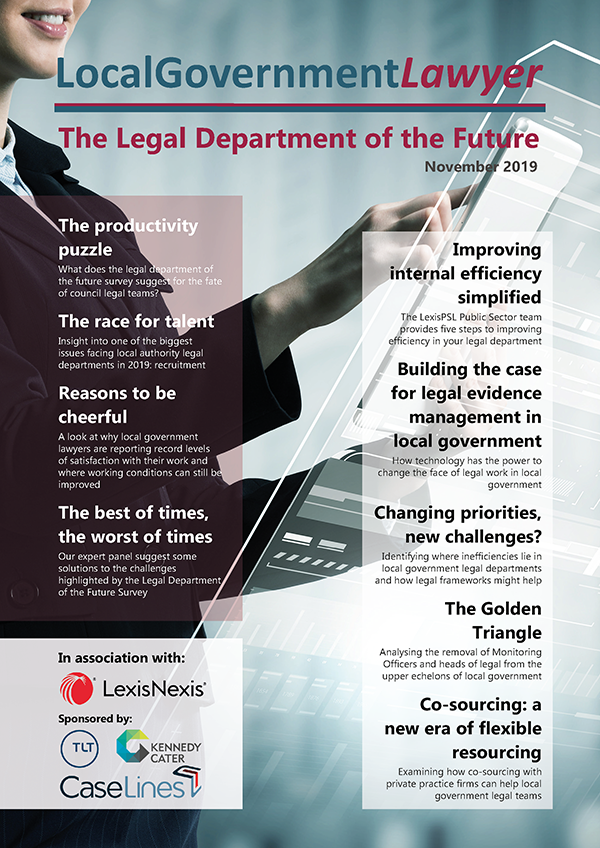Improving internal efficiency simplified
The LexisPSL Public Sector team provides five steps to improving efficiency in your legal department.

What is continuous improvement?
The definition of ‘continuous improvement’ (CI) is often over-complicated and buried in jargon, but it means exactly what it says: continually looking for ways to improve processes, methods and procedures to:
- remove blockages
- make them as efficient as possible, and therefore save time and money
Improvements do not have to be major changes; a number of small but effective changes soon add up. CI tools and methods can help you fix processes that are no longer effective and review processes that may appear to be working but could still be improved to deliver greater efficiencies and cost savings.
Above all, CI is about engaging with individuals and pooling ideas, challenging the existing habitual ways of doing things and identifying a method of measuring the success or failure of new initiatives.
Five steps to improving efficiency
The simplest framework for making process efficiencies has five steps:
- Define – identify the issue or problem
- Measure – measure the cost and the impact
- Analyse – go through the data to fully understand what it is telling you
- Improve – generate, evaluate and implement solutions to the problem
- Control – remeasure to demonstrate effectiveness and embed into everyday activities
Step 1 - identify and define the problem
Waste is an indicator of inefficiency; therefore, identifying waste can help you identify process inefficiencies or bottlenecks.
Waste could come from a number of areas, for example:
- overproduction – printing hard copies of emails, producing extra unnecessary copies of documents
- inventories – overstocked stationery cupboards, duplicate orders for newspapers or periodicals
- transportation and handling – movement of paperwork around the organisation, unnecessary sign-offs
- human motion – travelling between offices, time spent tracking down missing information
- waiting – slow computer speeds, waiting on other departments, awaiting client instructions
- defects – data entry and/or time recording errors
- extra processing – entering data into multiple information systems, generating unused reports
Step 2 - measure the problem
Once you have identified a process that needs to be reviewed, the next stage is to ensure you fully understand that process from start to finish. You can do this by producing a process map that will give you a clear visual picture of the process and allow you to identify any bottlenecks.
Step 3 - analyse your data
Once you have all of the measures in place the next step is to identify what the causes are behind the problems identified. To ensure a long-term solution, you must address the cause of the issue rather than just treating the symptoms.
One method of identifying possible causes is a root cause analysis diagram (sometimes known as a fishbone diagram). As it is impossible to tackle everything at once you can prioritise the causes by scoring them according to how much they contribute to the issue and how costly and complicated they will be to fix. From here you can start to generate some creative solutions and evaluate them before deciding how you will move forward and implement your improvements.
Step 4 - improve the process
Once you have selected which issue you will tackle first you need to begin the task of making improvement. One model for doing this is:
- sort – identify necessary items and remove unnecessary ones
- simplify – locate what you need and limit the amount stored
- sweep/shine – make sure everything is stored where it is supposed to be
- standardise – ensure the process is/can be adopted by everyone
- sustain self-discipline – ensure new systems are adhered to
It is also necessary at this stage to identify what training will be required, what resources will be needed to support individuals and what the overall costs of that will be both in time and money.
Before implementing a major change it is advisable to run a pilot programme to test and measure the results and iron out any issues before launching organisation-wide. Once you have run a pilot event you can produce a more detailed business case to support your argument for change.
Step 5 - make changes and get people on board
There are many different theories about how to implement change within an organisation, but perhaps the best known and most often referred to is John P Kotter’s eight-stage model. The eight stages follow a logical process for embedding change and engaging with employees:
- create a sense of urgency – make sure everyone understands the need for change
- form a powerful guiding coalition – put together a visible team of people to lead the change
- create a vision for change – a need to change that goes beyond facts and figures and engages with everyone
- communicate – use every method at your disposal and be prepared to ‘walk the walk’
- remove obstacles – identify and remove things that will get in the way of change
- create short-term wins – celebrate the small successes along the way
- consolidate improvements – don’t take your eye off the ball too soon
- anchor the changes into corporate culture – amend job descriptions, appraisals etc
Individuals can react in a wide range of different ways when changes are being implemented. These reactions could range from anxiousness, fear of the unknown, denial (they will never do it) to hopefulness and excitement about the future. These feelings are usually affected by how big the change is, how much control they have over it and how much it is going to affect them.
Most people go through four distinct phases of emotional reaction and you need to have support mechanisms in place to ensure the smooth implementation of the new processes.
Measuring success
To ensure the new process is properly evaluated you will need to measure the results delivered and compare them to those anticipated in your business case. A control chart will allow you to monitor performance within agreed parameters and determine the stability of the improvements.
If your goals are achieved, you will need to:
- calculate the value to the organisation of the changes you have made
- identify any additional capacity in the process as a result of the changes
- investigate the reasons if the results markedly exceed the target
If your goals are not achieved, you will need to:
- calculate as specifically as possible the difference between what was expected and the actual results
- determine whether the time period was appropriate – if results are improving but by less than anticipated, is it because you need longer to implement the changes?
- be prepared to admit if the project failed but identify what has been learned
- When demonstrating success, you need to be as clear as possible. Many people are confused by complex financial statements and reports, so only disseminate what you need to and include graphs and charts wherever possible.
Finally, if the project has been successful ensure it is rolled out to other departments or offices, but if it has been unsuccessful analyse it and understand why and retain the data for possible future projects. In both cases the last step should be to return to the beginning to identify the next round of improvements that could be made.
If you would like to read more, register for a one-week free trial at www.lexisnexis.co.uk/LDOTF

This article appeared in the Legal Department of the Future report, published in November 2019. To read or download the full report, please click on the following link: http://www.localgovernmentlawyer.co.uk/legal-dept-of-the-future

